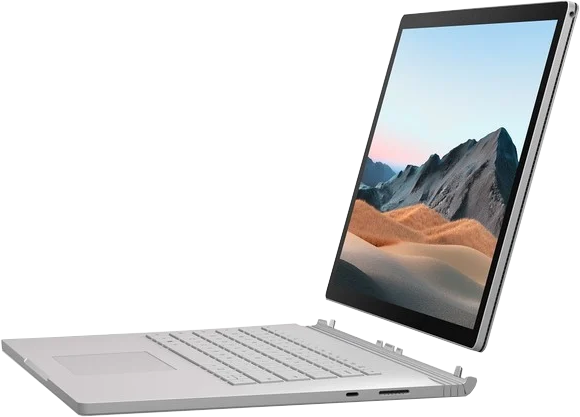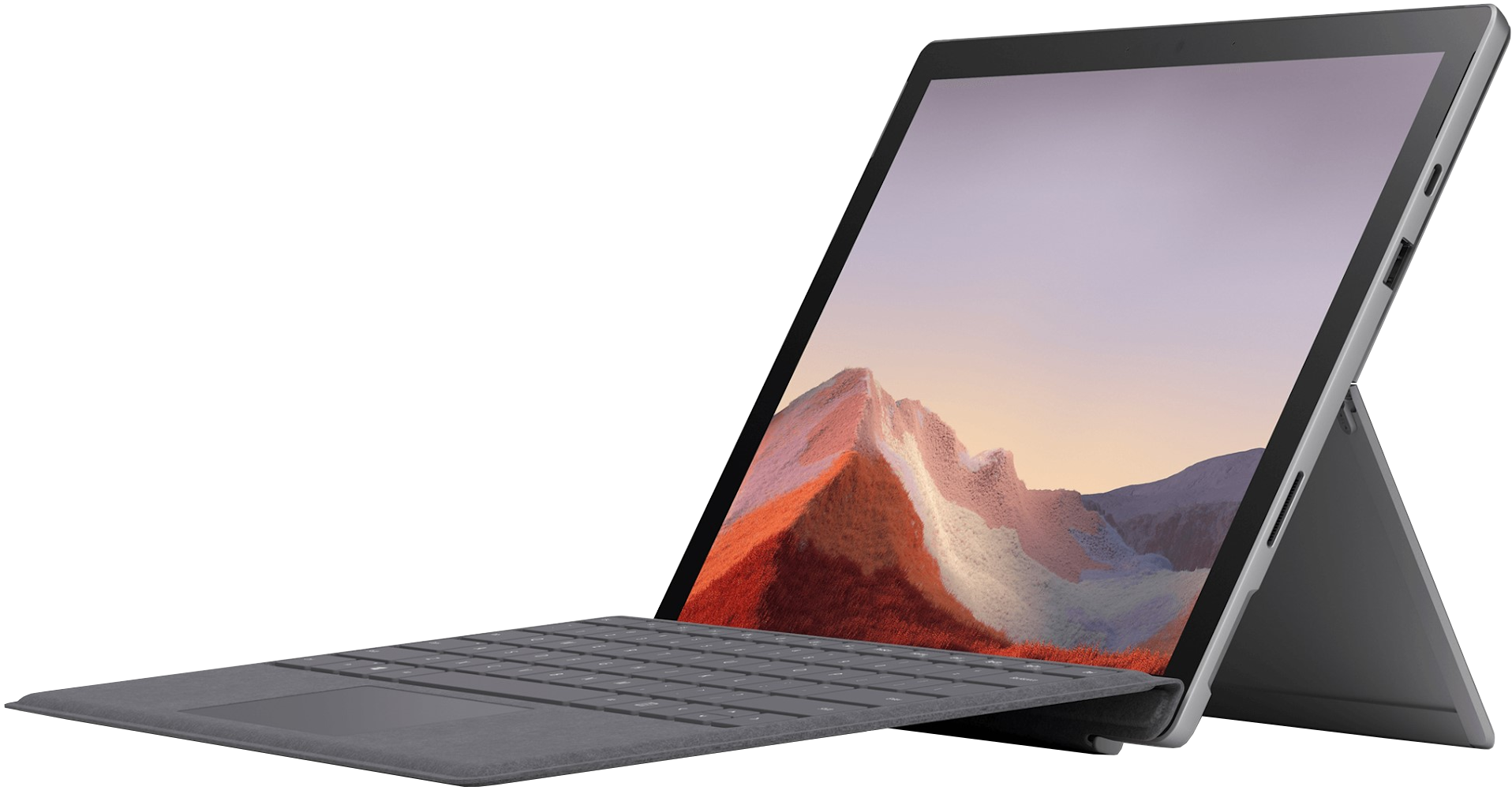New Surface Book
Surface Book 3
Pros
- 10th Gen Intel Core "Ice Lake" CPUs
- Wi-Fi 6
- Better battery life
- Dedicated GPU options
Cons
- Not quite as portable
- More expensive
The Surface Book 3 comes rocking 10th Gen Intel processors, dedicated NVIDIA graphics, faster RAM and storage, as well as Wi-Fi 6 and better battery life. This makes it the most powerful Surface Book to-date. It's just not quite as portable or affordable as the Surface Pro 7.
Pro Tablet
Surface Pro 7
Pros
- 10th Gen Intel Core "Ice Lake" CPUs
- Wi-Fi 6
- Lower starting price
- More portable
Cons
- No dedicated GPU options
- Pay extra for Type Cover
- Battery not as large
Microsoft's Surface Pro 7 is the most powerful Surface tablet, also housing 10th Gen Intel processors, supporting Wi-Fi 6, and coming with plenty of configurations available. It's also more affordable and better for those who want a more portable Surface PC. Just be prepared to endure the lack of any dedicated GPU, additional cost for the Type Cover, and charging more often.
Both of these devices are quite similar regarding the internals, but it's the design and functionality where everything changes. While the Surface Book 3 is technically a 2-in-1, it's designed as more of a traditional notebook experience, whereas the Surface Pro 7 is a tablet through and through. Whether you need a laptop or tablet will undoubtedly make your decision a little easier. Surface Book 3 also comes rocking dedicated graphics processors and far longer battery life.
Surface Book 3 vs. Surface Pro 7: tech specs
| Surface Book 3 | Surface Pro 7 | |
|---|---|---|
| OS | Windows 10 | Windows 10 |
| Processor | 10th Gen Intel i5-1035G7 10th Gen Intel Core i7-1065G7 |
10th Gen Intel Core i3-1005G1 Core i5-1035G4 Core i7-1065G7 |
| RAM | 8GB LPDDR4x 16GB LPDDR4x 32GB LPDDR4x |
4GB LPDDR4x 8GB LPDDR4x 16GB LPDDR4x |
| Storage | 256GB 512GB 1TB 2TB |
128GB 256GB 512GB 1TB |
| Display size | 13.5 inches 15 inches Touch |
12.3 inches Touch |
| Display resolution | 3000x2000 (267 PPI) 3240x2160 (260 PPI) |
2736x1824 267 PPI |
| Aspect ratio | 3:2 | 3:2 |
| Graphics | Intel Iris Plus GeForce GTX 1650 (Max-Q) GeForce GTX 1660 Ti (Max-Q) NVIDIA Quadro RTX 3000 |
Intel UHD (i3) Intel Iris Plus (i5, i7) |
| Ports | Two USB Type-A 3.1 (Gen1) One USB Type-C w/ video, power in/out and USB 3.1 (Gen1) data Full-size SDXC card reader (UHS-II) Headphone jack (3.5mm) Two Surface Connect ports (1 in tablet, 1 in keyboard base) |
USB-C 3.1 USB-A 3.5mm audio Surface Connect microSD card reader |
| LTE | No | No |
| Camera | Front-facing 5MP (1080p) Rear-facing 8MP (1080p) |
Front-facing 5MP (1080p) Rear-facing 8MP (1080p) |
| Biometrics | IR camera | IR camera |
| Battery | 70Wh (13.5-inch), 80Wh (15-inch) Up to 17.5 hours |
Up to 10.5 hours |
| Dimensions | 13.5-inch Book 3 12.3 x 9.14 x 0.51 - 0.90 inches (i5) 12.3 x 9.14 x 0.59 - 0.90 inches (i7) 15-inch Book 3 13.5 x 9.87 x 0.568 - 0.90 inches |
11.5 x 7.9 x 0.33 inches (292mm x 201mm x 8.5mm) |
| Weight | 13.5-inch from 3.38 pounds (1.53kg) 15-inch from 4.2 pounds (1.9kg) |
From 1.7 pounds (775g) |
Features and design
Microsoft didn't change much with the physical design of the Surface Pro 7 compared to the Pro 6, aside from adding a USB-C port. The same goes for the Surface Book 3. It looks almost identical to a Surface Book 2. While the Pro 7 has USB-A for older devices, a 3.5mm audio jack, Surface Connect, and a microSD card reader, the larger Surface Book 2 can make use of its more substantial form factor with two USB-A 3.1, USB-C, two Surface Connect ports, 3.5mm audio, and a full-size SD card reader.
The Surface Pro 7 is designed first and foremost as a tablet, which you can add a Type Cover for a notebook-esque experience. Surface Book 3 comes as a complete notebook package with a display, keyboard, and touchpad. The display part can be disconnected from the base unit and used as a tablet (since all the inner workings are found within), and it can even be re-connected facing the other way.
Both devices use IR cameras for biometric security with Windows Hello and use similar shooters for video calls and photos. It's all about whether you want a portable tablet or a more powerful laptop.
Display and inking
Surface Book 3 comes in 13.5-inch and 15-inch flavors. The smaller display has the same 267 pixel-per-inch (PPI) count as the 12.3-inch Pro 7 display, but the larger 15-inch falls a little shorter at 260 PPI. The larger Surface Book 3 comes equipped with higher resolution, but no matter which device you choose, you'll appreciate just how good the screens are.
All three Surface PCs have an aspect ratio of 3:2, and all are compatible with Surface Pen for inking. Four thousand ninety-six levels of pressure sensitivity and tilt support are present throughout, and you can combine a Surface Dial for improved productivity — though the Pro 7 only supports the dial off screen.
Performance and price
Like other Microsoft PCs, Surface Book 3 can be configured with various specifications. The 13.5-inch model is available with the same 10th Gen Intel processors the larger 15-inch model has, though you won't be able to enjoy either the NVIDIA GeForce GTX 1660 Ti (Max-Q) or Quadro RTX 3000 dedicated GPUs. The smaller Surface Book 3 can only take the GTX 1650 (Max-Q) or Intel Iris Plus.
The same goes for storage, which can go up to a whopping 2TB with the 15-inch Surface Book 3. RAM is the same for both sizes. Pricing starts from $1,600 and $2,300 for the 13.5- and 15-inch Surface Book 3, respectively. Where the Surface Book 3 truly shines against the Surface Pro 7 is battery life, allowing you to go up to 17 and a half hours before needing to find a power outlet.
That's so long as you keep the tablet portion of the Surface Book 3 connected to its keyboard base (which also houses an additional battery). The battery on the Pro 7 is around 10 hours. But you won't be stressing it with games since you can't upgrade to dedicated GPUs inside the tablet like you can in the Surface Book 3. However, it'll keep up with most tasks and allow you to use it on the go, thanks to its lighter build.
The best part about Surface Pro 7 is the price, which comes in at $749, a massive discount compared to the Surface Book 3. Though do keep in mind that Type Covers are sold separately.
Go with the Surface Book 3 if you're a power user
Surface Book 3 is the one you need if you're planning to run intensive software like video editing suites. The dedicated GPUs, powerful 10th Gen Intel CPUs, and speedy LDDR4x RAM make it quite the capable machine. You can remove the main display from the keyboard base and use it as a tablet, though it will not feel as portable as the Surface Pro 7.
New Surface Book
Surface Book 3
Power machine
You get a more rounded performance from the Surface Book 2 thanks to a dedicated GPU, and it's available with a larger 15-inch display. It's the right pick for power users, especially if you're interested in a better gaming experience.
Surface Pro 7 is a better portable, more versatile PC
Surface Pro 7 is best suited to those who value portability over all else. You still get the same 10th Gen processors from Intel, support for Wi-Fi 6, all wrapped up in a tighter, lighter package. The only downside is the slightly poorer battery life, lack of any dedicated GPUs, and additional cost for Type Covers. It's on our list for best Windows 10 tablet too.
Pro Tablet
Surface Pro 7
Better portability
The Surface Pro 7 was refreshed with new CPUs and a USB-C port. It's an ideal device if you want to stay mobile yet have the performance to crush a day's work.
 Reviewed by admin
on
March 14, 2021
Rating:
Reviewed by admin
on
March 14, 2021
Rating:


No comments: